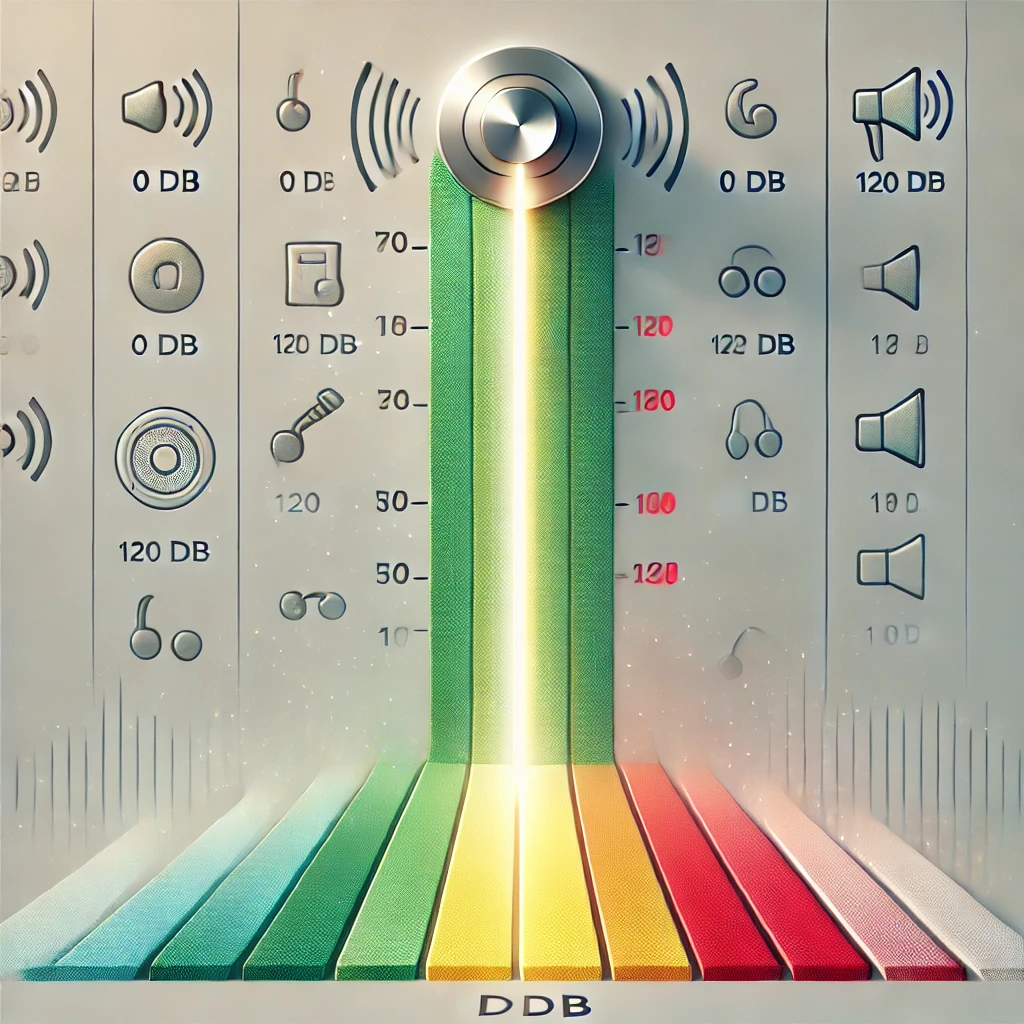
How is sound volume measured? What do decibels (dB) mean?
Mike MunayShare
The sounds we hear every day can be soft or very loud, but how can we measure how loud a sound is? This is where decibels (dB) come into play, which is a scale we use to measure the volume of sound, but what exactly do those numbers mean?
If you have ever asked yourself at least one of these questions:
- How is sound measured?
- What do decibels mean?
- Why isn't the noise scale linear and the difference between a soft noise and an annoying one very small?
This article is for you.
But first things first:
What is sound?
Sound is a form of energy that moves through the air (and other media) in waves. When something vibrates, such as the strings of a guitar or the top of a drum, it creates sound waves that propagate in all directions. These waves make the air around them vibrate and, when they reach our ears, they make small parts inside them vibrate, which allows us to hear.
Technically, sound is characterized by its frequency, measured in hertz (Hz), which determines the pitch (high or low), and its intensity, measured in decibels (dB), which determines how loud we hear it.
The speed of sound varies depending on the medium through which it propagates. Here are some examples of the speed of sound in different media:
- Air: At 20°C (room temperature), sound travels at about 343 meters per second.
- Water: In freshwater at room temperature, sound moves at approximately 1,482 meters per second.
- Steel: In steel, sound can move much faster, reaching speeds of about 5,960 meters per second.
- Glass: Sound travels through glass at a speed of around 5,600 meters per second.
These speeds can vary depending on factors such as temperature and the density of the medium. In general, sound propagates faster in denser and more rigid media, such as metals, than in less dense media like air or water.
How is sound measured?
Sound is primarily measured in decibels (dB), which is a unit that describes the intensity or sound pressure level. Here's how it works:
Sound Pressure: Sound is produced by pressure variations in the air or other media. These variations are measured in pascals (Pa).
Decibels: Decibels use a logarithmic scale, meaning a small increase in dB represents a large increase in sound intensity. For example, a sound of 10 dB is 10 times more intense than a sound of 0 dB, and one of 20 dB is 100 times more intense than one of 0 dB.
Measurement: To measure sound, devices called sound meters are used. These devices capture the sound and calculate its level in decibels based on the sound pressure they detect.
We use a logarithmic scale to measure sound because this scale more accurately reflects how the human ear responds to changes in sound intensity.
- The human ear has a very wide dynamic range to detect sounds of very diverse intensities, from the softest whisper to the most deafening roar. This range includes intensity variations of up to a million times in terms of sound pressure, which is impractical to handle on a linear scale.
- Experimentally, it has been observed that the perception of sound intensity by the human ear is not linear, but logarithmic. This means that a linear increase in acoustic energy does not translate into a linear increase in the perception of its intensity.
- The decibel scale, being a logarithmic scale, converts the wide range of intensities into a more compact and manageable scale. An increase of 10 dB is always perceived as approximately twice the intensity of the sound, regardless of the starting point. This simplifies the quantification and comparison of noise levels in practical and technical terms.
The measurement in decibels represents a logarithmic relationship with respect to a predetermined reference intensity. This reference intensity is 20 \(\mu \text{Pa}\) (micropascals), which is the lowest sound pressure that the human ear can detect under ideal conditions, known as the threshold of hearing.
Therefore, decibels express the ratio of the intensity of a sound compared to it in a logarithmic manner. For example, a sound that measures 20 dB is 100 times more intense than the reference level because \(10^{20/10} = 100\). This logarithmic approach helps to manage and compare the wide range of sound intensities that the human ear can perceive more effectively.
In addition to using pascals to measure sound pressure, watt per square meter \((W/m^2)\) can also be used to represent the sound intensity. Sound pressure is a direct measure of the pressure variation in the air or another medium due to the propagation of sound waves. It is measured in pascals (Pa) and reflects the force with which the medium's molecules are compressed and decompressed by the sound wave. Sound intensity is a measure of the acoustic power transmitted through a unit area. It is expressed in watts per square meter \((W/m^2)\). This measure considers both the sound pressure and the particle velocity in the medium, providing an indication of how much energy is being transported by the sound wave through the medium.
The relationship between sound intensity and sound pressure is defined by the equation \(I = p^2 / (c \rho)\), where p is the sound pressure, c is the speed of sound in the medium, and \(\rho\) is the density of the medium. This equation shows how the energy (intensity) depends on the sound pressure and the properties of the medium.
Formulas for calculating decibels (dB)
Formula using Pascals
\(L_p = 20 \log_{10} \left(\frac{p}{p_{\text{ref}}}\right)\)
Where:
- \(L_p\) is the sound pressure level in decibels (dB).
- \(p\) is the sound pressure measured in pascals (Pa).
- \(p_{\text{ref}}\) is the reference sound pressure, commonly \(20 \mu \text{Pa}\) for air.
Formula using watts per square meter
\(L_I = 10 \log_{10} \left(\frac{I}{I_{\text{ref}}}\right)\)
Where:
- \(L_I\) is the sound intensity level in decibels.
- \(I\) is the sound intensity in watts per square meter \((W/m^2)\).
- \(I_{\text{ref}}\) is the intensity reference, usually \(1 \times 10^{-12} W/m^2\) for air.
Examples of sound intensities on the logarithmic scale of decibels (dB)
- 0 dB: Human hearing threshold, the softest sound a person can perceive under ideal conditions.
- 10-20 dB: Soft whispers, leaves rustling.
- 30 dB: Quiet library, whispers at a meter's distance.
- 40 dB: Quiet room in a house, the hum of a refrigerator.
- 50 dB: Moderate rain, conversation at home.
- 60 dB: Normal conversation, air conditioning at three meters.
- 70 dB: Vacuum cleaner, car traffic at a moderate distance.
- 80 dB: Heavy traffic, phone ringing, alarm clock.
- 90 dB: Lawnmower, garbage truck.
- 100 dB: Motorcycle, small rock concert.
- 110 dB: Rock concerts, chainsaws.
- 120 dB: Ambulance siren nearby, airplane takeoff at close range.
- 130 dB: Pain threshold, jackhammer, fireworks display.
- 140 dB: Gunshot, rocket launch.
Interesting Facts:
- Sound travels almost five times faster in water than in air, but it also attenuates much more quickly.
- The human hearing threshold is the minimum intensity needed for the average ear to detect a sound. It is set at 0 decibels (dB), which does not mean the total absence of sound but the softest sound a person can perceive under ideal conditions.
- From 130 dB, sound becomes physically painful to human ears. This intensity can cause immediate hearing damage and is commonly experienced close to gunshots and explosions.
- Sounds below 0 dB still exist but are beyond the normal range of human hearing. These sounds are considered subaudible.
- The human ear can detect frequencies from about 20 Hz to 20,000 Hz. However, we are most sensitive to frequencies between 2,000 and 5,000 Hz, which is the frequency range of the human voice.
- The loudest sound that can be measured safely is about 194 dB, as higher levels cause sound pressure to become a shock wave (an abrupt and extremely rapid change in pressure), which is more an impact phenomenon than an audible sound. This wave is similar to those emitted by supersonic jets when they exceed the speed of sound.
